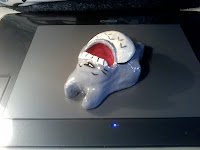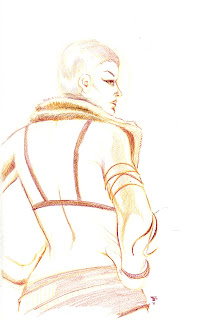The figures are lithe, twisted in action, reaction, ecstacy, despair, and the choking out of a death rattle. The colors could redefine garish, subtle; there are whole new qualities to the definition of "mauve" than you've ever appreciated. In the narrative of each piece, there is nothing written, and certainly nothing illustrated, on the nose. The book is likely the first ever in hot pink with an ax on the cover.
 Overkill: the art of Tomer Hanuka
Overkill: the art of Tomer Hanuka
Deliciously, Tomer has shown us his working process on Tropical Toxic for years, which, instead of de-mystifying the process, has only made me appreciate his stuff more, especially seeing the pieces printed larger, where i can start to appreciate the liveliness of his holding lines and the inexactness of with which they're being applied.
And, of course, its all commercial work, and interestingly enough, the book holds together by technique and approach, not subject matter. We know that we're looking a myriad number of commercial assignments, not even in chronological order, so the glue here is
viewpoint. And what a viewpoint it is. In every piece the camera is tilted or the figure is twisted or the light or fabric is shifted so that there is nothing settled, nothing at rest within the single panel narrative. Tomer mentions in sole text page in the back of the book about wanting to do slick American work, but it ended up with a middle easterner's anxiety underneath. And what anxiety it is. The contortion of limbs whether in violence or sexual climax mirrors the rending of cloth or flesh in decidedly non-linear fashion.

And the colors? Well, yes, the colors. tomer uses color in a very different fashion than most. There is a new palette that we see this generation using, James Jean and a whole bunch of others in Juxtapoz. While we initially saw everyone with Photoshop immediately go full color in every direction, Tomer has gone the opposite, limiting the work to four or five colors. It is interesting to note in the back that he mentions that he colors up a "regular" version, before experimenting with what are some of the most amazing combinations of shades, combining fades, dropped holding lines and sillouettes into astonishing menageries of single panel narratives.
And, yes, the final ingredient is that everyone of these pictures was the weight of narrative to them. they exist not just as that single frame, but encapsulate some of the story or article that they accompany. That we need not see the story to begin to guess from the clues shows how much visual communication is happening here. From the scattered wrapper on the floor to the line of coke on the woman's naked torso, story is unfolding everywhere you look.
I've been clipping the small accompanying illustrations that Tomer used to do for the New yorker before realizing that, after a few months, i was clipping pieces by the same artist. Clearly his aesthetic was working for me. Luckily, now i have hardback to go to over and over. You should to.
 Was rereading some of the old Sandman comics, and marveling at all the balls that Neil kept juggling through the series. Of course he bit off a bit more than he thought for the final Kindly Ones storyline, but it was one hell of a ride.
Was rereading some of the old Sandman comics, and marveling at all the balls that Neil kept juggling through the series. Of course he bit off a bit more than he thought for the final Kindly Ones storyline, but it was one hell of a ride.











